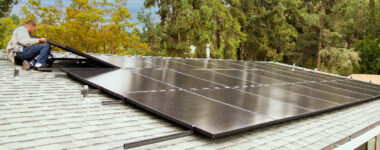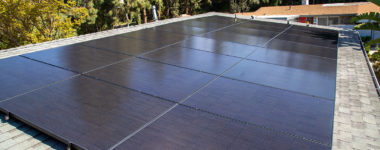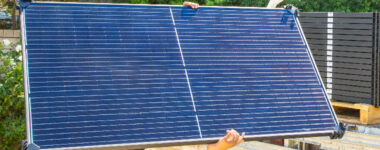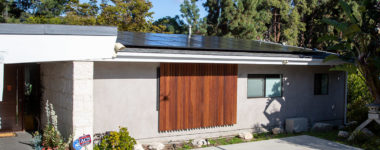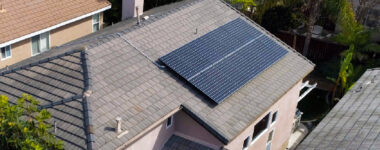Semper Solaris Blog
Have you been thinking about investing in solar panels for your home? Solar energy is a prime example of clean energy. It relies only on the power of the sun to produce electricity. “Clean energy” is a term that describes energy produced without pollution. On average, a single home solar panel provides roughly 3,400 kilowatt-hours of electricity per year, all without producing pollution. Homes with solar panels are valued higher on the real estate market, and homeowners can significantly reduce their utility bills by installing solar panels. Still not convinced? Learn more about the benefits of having solar panels for your home. Understanding the Benefits of Installing Solar Panels for Your Home The primary barrier to the widespread adoption of residential solar energy is the cost, which can be in the tens of thousands of dollars per home. But according to a study by the Lawrence Berkeley National Laboratory, the price of solar installation is dropping fast. The median price of an installed solar power system fell by 60 percent over a span of 15 years, from $12 per watt in 1998 to $4.70 per watt in 2013. This price adjustment is before any incentives, such as government rebates or tax breaks, are factored into the cost. The declining price of solar energy is due to increases in the efficiency of production as well as the amount of power a solar cell can produce. In addition, many homeowners who install solar energy systems will be eligible for government tax credits and rebates that will lower the cost even more. Solar panels require very little maintenance and can last between 25 and 45 years because they have no moving parts. The benefits of switching to solar power are numerous, and they include reducing current levels of pollution, lowering electric bills, gaining a higher home resale value, and, in some cases, benefiting from a self-sufficient home power grid. A home that relies to some degree on solar power is inherently reducing its pollution footprint. Solar panels for your home do not burn any fossil fuel, as they rely only on sunlight to produce electricity. Solar power does not produce any harmful emissions, such as greenhouse gasses, and does not contribute to global warming or acid rain. Replacing the traditional system of power plants with solar panels would reduce the cases of respiratory and even cardiovascular illnesses that occur due to air pollution. In addition, solar panels lack the moving parts found in wind energy systems, which means that solar power also does not present any threats to birds. As a homeowner, you can significantly reduce your utility bills by installing solar panels for your home. Depending on the area, homeowners may also be able to sell some power back to the utility grid if their solar panels produce more than their household uses. Home energy prices have risen an average of 3 percent per year since 2002, while solar panels have dropped in price, making solar power an increasingly competitive option compared to relying on utility companies. And solar panels for your home can reduce the cost of energy for everyone, including neighbors who do not have solar energy. Using solar power drives down the demand for electricity from the grid, especially during the summer, when the cost per kilowatt-hour and demand for electricity are the highest. Furthermore, in areas where solar-powered homes contribute electricity to the grid, it enables utility companies to draw power from these cheap sources rather than turning to more expensive power plants. According to a Boston University study by professor Robert Kaufmann, solar-powered homes currently deliver a price drop of one cent per kilowatt-hour in Massachusetts, where the average cost per kilowatt-hour is 15 cents. A home with solar panels will sell for a higher price than other homes that do not have them. According to a study done in January 2015 by the Lawrence Berkeley National Laboratory, the sale price of a home with a solar array goes up by an average of $15,000. That figure comes out to an additional $4 of resale value per watt of power produced by the installed solar energy system. This resale value pertains primarily to homes with panels that have already been fully paid for. Homes with solar panels installed enjoy a varying level of energy independence. Inherently, these homes will enjoy strong protection from utility cost increases. Depending on the utility, a home with solar panels may also become a generator of electricity by selling power back to the grid. Homeowners will often also install batteries that can store electricity for use when it’s cloudy or during power outages. Although this option is more expensive, a sufficiently powerful system of batteries and solar panels can enable a home to run without relying on the grid at all. Are you ready to invest in solar panels for your home? Contact your local California solar power provider. Protecting the Environment Energy, Economic, and Environmental Benefits of the Solar America Initiative (PDF) Renewable and Alternative Energy Energy From the Sun Reducing Energy Bills Solar Energy Solar Power Saves Everyone Money Reduce Your Energy Costs Increasing Property Value Solar Energy Resources for Homebuilders Energy Independence How Many Solar Panels Do I Need on My House to Become Energy-Independent? Solar Panel Installation Costs Tracking the Sun (PDF) Going Solar in America (PDF) Solar Power for Your Home: A Consumer’s Guide (PDF) Should You Put Solar Panels on Your House? Solar Companies Solar Orange County Solar Companies Bay Area Solar Panels Solar Panel Companies San Diego Solar Panel Installation Best Price Solar Solar Panel Installs
Solar power is one of the most plentiful renewable energy sources in the world, especially in areas such as California that enjoy the benefits of clear skies on a regular basis. Some people may be resistant to the idea of solar power because they simply don't understand how solar panels work. However, solar power is a solid choice for residents in the San Diego area. If you're not sure how solar panels work, you've come to the right place. The Rundown on Solar Power In short, solar power provides electricity for homes and buildings. It is so effective that it can be used in place of traditional electricity or other sources of energy. The word “solar” comes from the Latin word for “sun.” “Solar power” refers to the powerful energy we get from the sun. Thousands of years ago, people realized the power of the sun, and even then, people tried to use solar power to make their homes more comfortable in the winter. It’s a reliable, eco-friendly energy that doesn’t run out and doesn’t create pollution the way some sources of energy, such as gas or coal, can. Today, especially in California, solar power is a fitting source of energy, thanks to the state’s conducive climate. Harnessing Solar Energy in California As the sun shines down on the Earth, different areas can collect different amounts of solar power. San Diego, California, for example, is a warm and sunny city that gets a lot of intense sunlight throughout the year. In fact, all of Southern California is an ideal place for solar energy collection. California solar power companies in this area use solar thermal collectors, which absorb heat energy from the sun. This energy is then used to heat water or make electricity. If a system is big enough, the cells that turn sunlight into electricity can even make enough electricity for a whole neighborhood. An area that’s open to the sky and without too many trees overhead is needed to collect solar energy. Solar Energy Four Ways to Do Solar Energy Solar Energy Technology Basics Solar Power Saves Everyone Money How Solar Panels Work Solar panels are set up so that the sun shines down on them at an ideal angle. When the sun hits the panels, tiny solar cells, also called photovoltaic cells, absorb the sunlight. These cells might be as small as a half an inch or as large as 4 inches each. The solar cells then absorb the energy and use it to move electrons to a second layer of the cells. When the electrons hit the second layer, this action forces other electrons to move down, too. This movement of electrons is actually electricity, which can power appliances in a house. In the United States, California solar power is prominent due to the abundant sunshine and heat in this area. California was early to adopt the solar power movement. For example, the Mojave Desert in southern California has a solar power plant that has been running for decades. Solar Energy How Solar Panels Work: A Simple Explanation The Environment: Solar Energy How Does Solar Power Work? Renewable Energy Sources Solar Power Learn About Solar Power How You Can Use Solar Energy in the Home Whether you live on the coast, inland, atop rolling hills, or in the mountains, California residents in all regions can find multiple uses for solar energy in the home. With solar panels, you can collect solar energy to use for air conditioning, to heat water, and to power appliances. A battery can store extra energy so that the house can have power at night and on cloudy days, like those signature “May Gray and “June Gloom” months sunny SoCal often experiences. Solar Basics Solar Power Facts DIY Projects Using the Sun A Kid’s Guide to Solar Power in the Home Meet the Sun Power People Should You Put Solar Panels on Your House? Kids Can Learn About Solar Power Some Solar Energy Fun California solar power is leading the future of energy. Want to learn more about solar energy? Activities like building a solar oven with a box, aluminum foil, and a few other materials can show you how to use the power of the sun to cook a fun snack. You could build a solar night-light out of a jar and a solar path light. Try out the following games, experiments, and activities to get a hands-on experience with solar energy. Solar Energy Coloring Book (PDF) How Solar Panels Work (video) Energy Games and Icebreakers Energy City Interactive Game California Solar Power Regions Served by Semper Solaris Take a look at the top locations we serve in California to find out more information about your city. San Diego Solar Orange County Solar Bay Area Solar Los Angeles Solar Inland Empire Solar If you’re interested in learning more about how solar panels work and how solar panels for home use can benefit you, contact a specialist such as Semper Solaris today.
In the state of California, solar power is becoming more and more popular. In fact, cities like San Diego have embraced solar power completely, and California solar energy users outnumber those in other states by a wide margin in many cases. Out of the top 10 solar-producing cities in the country, four of them are among California solar producers, and San Diego has been recognized as the leading solar-producing city in America. There’s no denying that California solar power leads the way in alternative energy production. Semper Solaris is proud to service San Diego, the leading city of solar power production in the United States. If you’re considering solar panels for home use and you live in the San Diego area, join the countless others who have already made the switch to California solar energy. Check out Semper Solaris to find out what a solar installation for your home could look like. Semper Solaris Services & Resources solar company san diego || solar installation los angeles || solar bay area || solar power palm springs || solar power orange county || free energy analysis
From businesses to homes, solar panel technology is used in numerous settings and industries. Beyond our planet, NASA uses solar panels on its satellites. These solar panels are produced by the same manufacturers that we at Semper Solaris use for our solar panel installations! Semper Solaris installs the finest solar panels on all of our installations We’re proud to be the recipient of multiple national solar power dealer awards. We choose only the best solar panels for good reason. If you’ve ever worried about the durability, efficiency, and effectiveness of solar panels, then you haven’t seen them in action. NASA’s Uses for Solar Panels NASA has used solar panels to explore the ice caps of Greenland, test the solar power capabilities of unmanned vehicles (crafted to explore distant planets like Mars), and create new possibilities for solar-powered aircraft. NASA used solar panels for a project in May 2013, GROVER (Goddard Remotely Operated Vehicle for Exploration and Research). Also known as the “Greenland Rover,” GROVER was operated entirely by solar energy. It received GPS coordinates from operators in Idaho, about 3,000 miles away from its location at the highest point of Greenland. Roughly 800 pounds, it was equipped with American-designed solar panels.GROVER was used to gather data in environments that would have been difficult or impossible for humans to work in. It used advanced radar technology to scan the depths of the ice and gather information. In the ice caps of Greenland, GROVER’s solar panels endured 30 mph winds and frigid temperatures as low as -22°F. Yet, for its five-week trial run, GROVER gathered its data, sustained by the ever-durable American-designed solar panels. GROVER wasn’t the only time NASA relied on American-designed solar panels. Not surprisingly, NASA experimented with drones (then called “Unmanned Aerial Vehicles,” or UAVs) long before they became available and popular in today’s market. One of these UAVs was named the Pathfinder Plus, and it was remotely piloted and powered by American-designed solar cells. In 1998, Pathfinder Plus set an altitude record: 80,201 feet. Many commercial airlines don’t fly far above 36,000 feet, which is less than half of the record for this unmanned aircraft! Another project culminated in 1999 when NASA worked together with Helios, a second-generation high-altitude, long-endurance (HALE) project, using similar unmanned vehicles. The panels were re-engineered into customized solar cells for Helios in order to create solar cells that would be able to survive the high air pressure of high altitudes and still create enough energy. These cells were also engineered to be as light as possible and to capture any and all scraps of light, even specifically light reflected off of clouds. In 2001, these new cells were efficient enough to enable Helios to set a new world record of over 96,000 feet. Efficient, American-Designed Solar Panels If solar panels designed in the US are the best option for NASA, they can be the best for your home or business. They’re efficient enough to capture light that reflects off of clouds and durable enough to withstand Greenland’s ice caps. Chances are, they’ll last long and work well on any sunny California rooftop!
Solar panels can do more for the planet than you can imagine. They can benefit underserved communities. Semper Solaris is proud to work with our American-designed solar panels provider, which partners with a program called GRID Alternatives. With the goal of making renewable energy technology available to those in need through affordable or no-cost solar initiatives, GRID Alternatives helps people and the planet through solar technology. GRID Alternatives has created several programs in order to benefit the community through solar power. Their core program involves providing affordable or no-cost solar for families with low incomes. They accomplish this objective through two incentive programs, the Low-Income Weatherization Program and the Single-Family Affordable Solar Homes (SASH) program. Solar Education and Training Along with providing means for these families to be able to have solar power and dramatically reduce their electricity bills, GRID Alternatives places a high emphasis on training people to be able to work in the solar industry. Through education and hands-on training, GRID Alternatives provides jobs and equips people who may otherwise struggle to find employment in the solar industry. GRID Alternatives operates several programs with this emphasis: RISE, a diversity initiative in solar work; the National Women in Solar Initiative; SolarCorps, which partners with AmeriCorps; Troops to Solar Initiative; and more. This comprehensive organization doesn’t stop there. GRID Alternatives also has a program that provides solar and solar installation training for Native American tribes in need, another program that recruits college students to install solar technology for those in need during their spring breaks, and a Multifamily Solar Housing program. Where Solar Panels Serve Communities GRID Alternatives’ effect goes beyond the United States. The organization has a powerful program based in Nicaragua where it builds solar systems for off-grid rural communities. These solar panels can provide consistent, lasting electricity for farms, schools, and medical clinics in these hard-to-reach communities. GRID Alternatives installs these systems with the help of volunteers and community members, and they continually return to the community to ensure that the systems are still beneficial. The GRID Alternatives has served over 950 families since it began in 2006. The organization has installed over 2,300 kilowatts of energy, which means a combined $17 million savings in energy costs for the next 25 years, the average lifespan of American-designed solar power systems. This huge burden can be lifted off of families who struggle to make ends meet, and GRID Alternatives’ efforts can help them get that extra bit of money each month to pay for necessities. The manufacturer of our American-designed solar panels also works in training and educating college students and K-12 students. With this training, these students can go on to get work in the solar industry or simply learn something new while helping their community! At Semper Solaris, we install the best solar panels. And we believe that American-made and American-designed panels are the best — not only because of their durability and efficiency, but also because American-designed solar panels contribute to important causes in our community. Receive an instant text quote in seconds and see how much you can save on our highest efficiency solar panels and solar installation capabilities. Go solar today!
More and more homeowners are looking into adding solar panels to reduce their environmental impact while lowering their monthly utility bills. As you consider the options available to provide power to your home, solar energy should be at the top of your list. This clean energy source is abundantly available, especially in the Southern California area, contributes to economic growth, and can become your long-term energy solution. Here are a few reasons you should add solar panels to your home. There is more potential in solar energy than we could ever possibly use. Even with more than seven billion people on Earth, the sun delivers more energy to our planet in one hour than all of humanity uses in an entire year. On average, the Earth receives a constant estimated 1,366 watts of direct solar radiation per square meter. That’s enough energy to power over 20 light bulbs for an hour. Even more impressive than how much energy the sun delivers in an hour—the sun delivers over 173,000 terawatts of solar energy continuously. This means that at any given moment, we receive more than 10,000 times the annual energy use of the entire world. In 2015, Congress enacted a bill that extended tax credits to those that invest in solar, whether residential or commercial. This means that more individuals and businesses can afford to invest in solar, and ultimately save money on their energy bills. Many companies, including Apple, Intel, Toyota, and Target, have been recognized for their solar installations and amount of solar capacity. These companies and others like them generate enough solar energy to offset around 890,000 metric tons of carbon emissions per year, which can cause serious harm to the environment. In 2020, total solar capacity is projected to hit 100 gigawatts, which is more than a 3000% increase in capacity compared to 2010. Not only are many more people installing solar, but it’s also becoming the most sustainable, efficient option. Solar panels, the panels that Semper Solaris installs, have produced 60% more energy per square foot than conventional panels in a study over 25 years, making our solar panels some of the best available. Solar panels also have a useful life of more than 40 years. This means that these panels still produce at least 70% of their original energy capacity for over 40 years—that’s well into the middle of the century! Solar is the clear choice if you want energy that won’t run out, benefits the economy and environment, and also benefits you. And if you’re looking for solar power that produces more energy for longer, solar panels installed by Semper Solaris are your best bet. Don't forget about adding battery storage to take full advantage of your solar panels. Learn more about adding solar panels to your home by contacting Semper Solaris, one of the leading California solar providers. Receive an instant text quote in seconds and see how much you can save on our highest efficiency solar panels.
Clean and renewable energy sources are the topics of global conversations and for good reason. Using a solar power system or other renewable energy sources can reduce pollution, provide improved efficiency, and change the way we use electricity. In the Santiago, Chile metro area, a solar power system has become a major player as the city’s metro system provider has partnered with a solar company to provide solar energy on a larger scale throughout the city. The El Pelicano Solar Project, near La Higuera and Vallenar in Chile, is expected to be complete by the end of 2017. Once finished, it will provide 300 gigawatt-hours per year of pollution-free solar energy to the Metro of Santiago. This solar power system will be used to power the first public transportation system in the world mostly run by solar energy. With 2.2 million passengers using the Metro of Santiago service each day, a whole lot of people will be enjoying more than the sun’s warmth; they’ll be benefiting from its endless supply of energy. Imagine the benefits to the environment when 2.2 million people give up pollution-belching gas or oil-fueled transportation in favor of clean solar energy. Chile is an ideal location for this ambitious solar power system project, as it’s committed to clean, sustainable energy sources for its bustling population of 18 million people. In fact, the northern end of Chile is the most solar-energy-intensive place in the world. The Chilean Ministry of Energy plans on at least 19% of the country’s energy supply to come from the sun by 2050, along with 23% from wind power and 29% hydroelectric. Total, the world’s second-ranked solar energy operator, is just the solar company to bring Chile’s dream to fruition. Not only will the completed solar power system provide cost-effective energy while optimizing the use of the land, but it will also include robotic solar panel cleaning capabilities to reduce water usage by 75% over traditional cleaning methods. In hot, dry Chile, that water conservation is precious. If an entire country can rely on the sun for its energy needs, you can certainly power up your own home with solar. A solar power system is clean, available, and cost-effective. It’s energy straight from the ultimate source: the sun. Receive an instant text quote in seconds and see how much you can save on solar panels.
Living in San Diego which bathes in sunshine year-long, it’s difficult to imagine a frozen landscape dotted with solar panels. ‘Cause ice and blazing sun don’t go together, right? Well, that’s the usual misconception, it seems. IceHotel in Sweden is the first-of-its-kind hotel that offers its guests a unique and memorable experience of staying in a space built almost entirely of ice. Now, the hotel has announced plans to have solar panels installed to keep it frosty all year round. The world’s first IceHotel has been rebuilt every fall for the past 26 years. This amazing riverfront building is constructed of ice blocks and snow retrieved from one of Europe’s rare wild rivers, the Torne River, and it is open until spring when Mother Nature reclaims it. However, Sweden’s largest solar company, Solkompaniet, and architect Hans Eek have partnered with the hotel and recently announced their plans to build solar retrofits. The PV panels will actually ensure the indoor temperature stays below freezing all year, keeping the hotel from melting. With the annex completed, Icehotel will scale 1,207 square meters, with 20 suites, a bar, and an art gallery. The hotel has actually been described as an art gallery and a hotel with its striking suite designs. The Swedish hotel is situated in Jukkasjärvi, a village almost 200 km away from the Arctic Circle. Every year artists and architects submit their design proposals for that year, so the hotel has never been the same. The addition of solar panels was put forward by a Gothenburg design company PinPin Studio. The studio proposed that the hotel have a permanent section that would harness the extreme north phenomenon called “the midnight sun.” The midnight sun means the sun never sets; it only glides over the horizon and stays visible 24 hours a day. This phenomenon happens in the summer months north of the Arctic Circle and south of the Antarctic Circle. Hotel officials say the permanent section could be ready and open by the end of 2016. Are you wondering how this phenomenon could be possible? The architect Hans Eek says it’s a simple principle. He explains it as the familiar “physics of Isaac Newton” that is normally applied to energy-efficient housing and intended to keep the cold out (or in California’s case, the heat), but they are reversing the process. If you are a sunshine lover, you probably don’t find the idea of an entirely frozen hotel the least appealing. But this hotel’s example proves how versatile and flexible green energy is in its applications. Do you want solar panels in Santee? Would you like to keep the heat out of your Santee, San Diego property, just like this frozen hotel? If you are thinking of installing PV panels and you are looking for a reputable and trusted contractor, Semper Solaris is your solar company. We are a veteran-owned and operated business that stands for all-American values. Your trust and satisfaction are our top goals, so we make sure that the solar panels we bring you are the best in class and that our workmanship is prompt, dependable, and high quality. Feel free to call us today for a no-cost quote. We are here to answer all your questions and bring solar closer to you!
We recommend this article: Utilities commission authorizes new revenue Monthly increase in a typical household’s SDG&E bill for gas and electric customers Utility bills will rise in September with approval Thursday of a four-year rate increase totaling more than $500 million for customers of San Diego Gas & Electric Co. A typical household will see monthly gas and electric bills rise about 11 percent to $132.02, up from $118.52, according to the California Public Utilities Commission. The company was granted a 7.6 percent revenue increase starting in 2012. The hike will be collected retroactively, so many bills will rise by more than that percentage to catch up. Now is the perfect time to lock in some energy savings in San Diego. Receive an instant text quote in seconds and see how much you can save on our highest efficiency solar panels.
Sempra Energy executives hope that state regulators will boost a proposed four-year, $723 million rate increase slated for utility customers in San Diego and southern Orange counties. Sempra subsidiary San Diego Gas & Electric has urged the California Public Utilities Commission and the lead commissioner in the proceeding, Mark Ferron, to restore several proposed cuts to its revenue requests, applied retroactively to the start of 2012. One key issue is how annual increases are calculated from 2013 to 2015. The state Division of Ratepayer Advocates estimates the SDG&E approach, using a utility-industry index, would add an additional $103 million to rates over the current proposal. SDG&E estimates $41 million is at stake. “We have made our concerns known and we expect, with a better understanding of the facts, most if not all funding will be restored,” Sempra CEO Debra Reed told analysts Thursday. Reed said a proposal to peg annual increases to the Urban Consumer Price Index would be an unfair departure from previous decisions at the utilities commission, while consumer advocates say it’s important to consider what people can afford. The proposed decision would bump up SDG&E revenues retroactively by $140.2 million to $1.75 billion, effective Jan. 1, 2012. That 8.7 percent increase would be applied to bills gradually to ease the impact. Receive an instant text quote in seconds and see how much you can save on our highest efficiency solar panels.
April 1, 2013 (San Diego) – On March 29, a California Public Utilities Commission (CPUC) administrative law judge proposed that SDG&E be allowed to increase rates for its customers by 7.7%. Ratepayers in San Diego are already paying among the highest utility rates in the nation. View the full decision here. “The people of San Diego need to stand up and speak out against this unjustifiable and unconscionable increase in electricity rates,” said Mike Aguirre, former San Diego City Attorney. Public comments should be sent to ALJ Wong at [email protected] and to the assigned commissioner; a current service list for the proceeding is available at www.cpuc.ca.gov. The proposed decision was issued by Administrative Law Judge John S. Wong, presiding officer in the proceeding. The matter may appear on the full CPUC agenda as soon as 30 days after the ruling. The full Commission may adopt all or part of the decision, modify the decision, or prepare its own decision. SDG&E and SoCal Gas claim their costs are increasing due to new regulations, increased materials cost, new technology and growth to meet new demand, as well as the need replace aging infrastructure. Consumer advocacy groups includint TURN (The Utility Reform Network) and UCAN (Utility Consumers Action Network) and others have opposed the rate hikes. Opponents contend that consumers have had to cut spending in this economy and that SDG&E and SoCal Gas should have to do so, too. The advocacy groups have also questioned the accuracy and methodology of forecasts used by the utility corporations. SDG&E has previously sought to force ratepayers to pay its uninsured liability costs for wildfires caused by its lines, a move the CPUC rejected. Opponents of major wind projects in southern California have long contended that a shift to more wind power sources would ultimately raise rates for utilities, since the technology is costly and hefty rate hikes have occurred elsewhere when utilities have added wind power to their portfolios. Locally, Ocotillo Wind came online in December and several more wind projects are proposed in East County. Receive an instant text quote in seconds and see how much you can save on our highest efficiency solar panels.
Consumer advocates, including the AARP, are saying they can live with a compromise by state regulators on how much San Diego Gas & Electric is authorized to profit from its capital investments on infrastructure. The California Public Utilities Commission late last week approved a 10.1 percent rate of return on common equity for SDG&E during the coming year. That rate is lower than the 11 percent rate sought by the utility serving San Diego and southern Orange counties, but considerably higher than initial recommendations by groups including the American Association of Retired Persons and the state Division of Ratepayer Advocates. “We would like to see it be a little bit lower if you look where the return on equity is relative to other utilities across the United States,” Michael Richard, of AARP California, told the commissioners shortly before the unanimous vote of approval. “But, on balance, we think it is a balanced decision.” The reductions translate into an average utility bill decrease in San Diego of $1.52 on electricity and 16 cents on gas, based on 600 kilowatt hours and 38 therms of consumption, according to commission estimates. For utility investors and ratings agencies, cost of capital proceedings are closely watched as a way to gauge future earnings potential. The proceedings set out to determine reasonable return on equity given current interest rates and risks. Federal executive agencies, a major power customer in the region, wanted further reductions, arguing that capital borrowing costs, as measured by average bond yields, have fallen dramatically since the last time utility return rates were adjusted in 2007. The Division of Ratepayer Advocates, an in-house consumer watchdog at the state utilities commission, also had lobbied for further reductions, but commended the final decision. Morgan Lee • U-T Receive an instant text quote in seconds and see how much you can save on our highest efficiency solar panels.
San Diego Gas & Electric is making a last stand for a plan to recover uninsured costs for the 2007 wildfires from utility customers, appealing to individual state utilities commissioners in several face-to-face meetings this month. What would utility investors pay? Two competing draft decisions would either reject outright SDG&E’s proposal for streamlining cost recovery for recent and future fires or prohibit the utility from including costs, including legal expenses, from the 2007 fires. Instead, the authors suggest, SDG&E should request approval to bill customers using long- standing procedures for major events seen as beyond the control of utility management. SDG&E is asserting that either draft decision, without amendments, would deprive the utility of a fair opportunity to recover costs for conducting business in a fire-prone region, as guaranteed under California law. A vote by the California Public Utilities Commission is scheduled for Thursday but may be delayed. The vote could help determine who ultimately is responsible — utility customers or shareholders — for 2007 wildfire costs currently estimated at $369 million, with roughly 1,750 court claims against the utility still unresolved. Consumer advocates are concerned that the utility’s request would undermine the vetting process that shields customers from unreasonable costs. Timothy Simon, the commissioner overseeing the proceeding, sought to allay those concerns during a wide-ranging discussion Monday in San Francisco involving the commission’s five members, SDG&E representatives and critics of the utility’s plan. “I think that the notion that there is no review … or that it is some type of blank check is clearly unwarranted,” said Simon, who indicated revisions to his draft decision were likely before a full commission vote. Triggered in large part by San Diego Gas & Electric power lines, three wildfires in October 2007 destroyed more than 1,300 homes and killed two people. The final bill is coming due five years after SDG&E exhausted $1.9 billion in insurance and counterclaims against contractors and a cable company linked to the fires’ ignition. SDG&E has pressed its cases with individual members of the San Francisco-based commission. Many critics of the SDG&E proposal have taken advantage of their own right to equal time with commissioners, who are appointed by the current and previous state governor. Commissioner Simon has embraced in principle SDG&E’s proposal for utility customers to pick up 90 percent of uninsured fire costs and legal expenses through the creation of a wildfire expense balancing account. Utility investors would pay the first $10 million and 10 percent thereafter. But the standard would not apply to the 2007 fires, and utility customers could not be charged without a court or commission finding that the utility was not at fault, under Simon’s draft decision. SDG&E has provided its own edition of a draft ruling to commissioners for guidance. Two of California’s four investor-owned utilities — SDG&E and Southern California Gas, both subsidiaries of Sempra Energy — are parties to the application. Southern California Edison and Pacific Gas and Electric dropped out of the proceeding. Administrative Law Judge Maribeth Bushey has recommended rejecting the SDG&E plan outright, arguing that it would thrust unlimited liability for damages onto utility customers while undermining incentives to reduce wildfire risks. Two state investigations found that SDG&E lines, and to a lesser degree Cox Communications equipment, caused the 2007 fires, which spread quickly under dry conditions and gusting Santa Ana winds. Cox has since paid SDG&E $444 million under a settlement agreement. San Diego Gas & Electric denies it was ever at fault, but it apologized previously for obstructing investigators looking into the root causes. In 2009, SDG&E agreed to pay $14.4 million to the state’s general fund to settle accusations that shoddy maintenance led to the blazes. Receive an instant text quote in seconds and see how much you can save on our highest efficiency solar panels.
